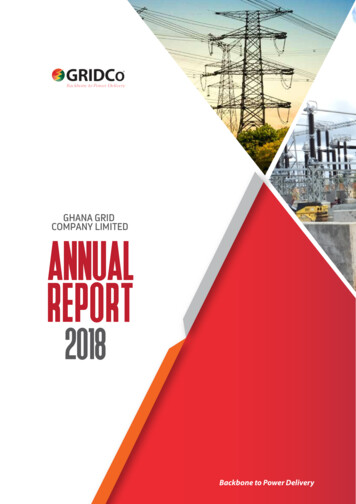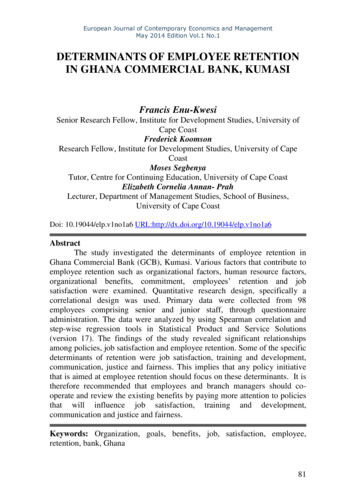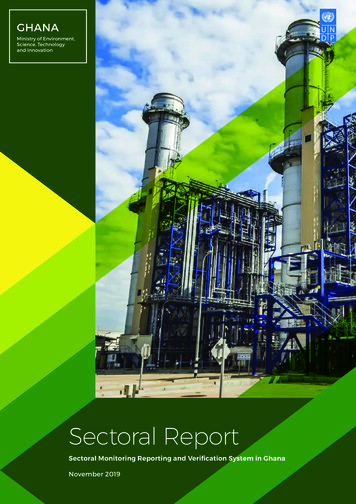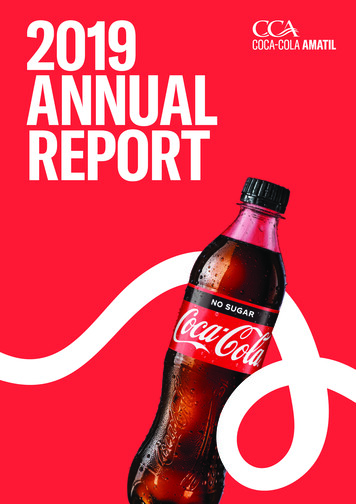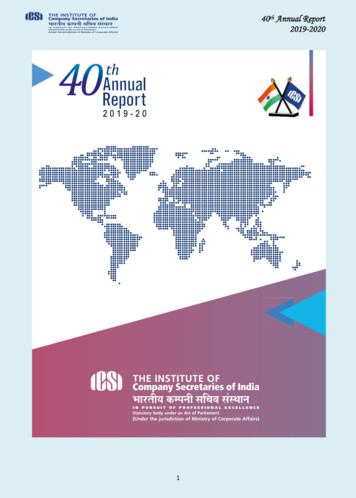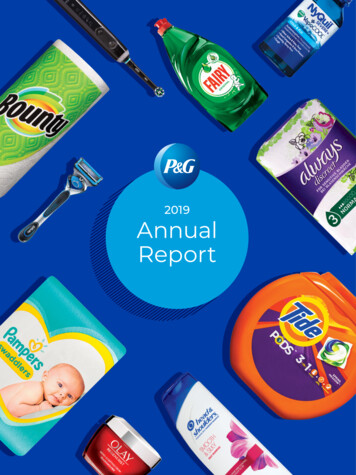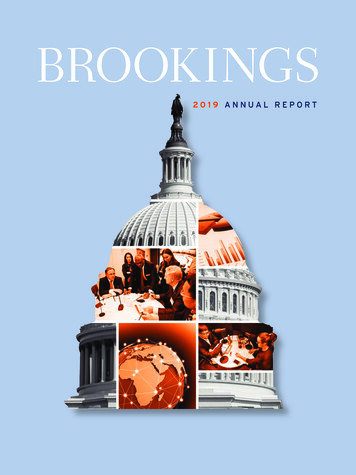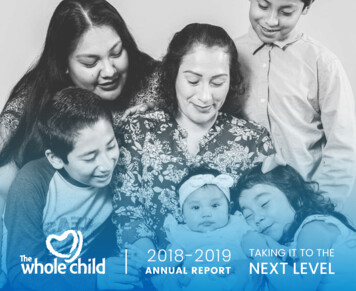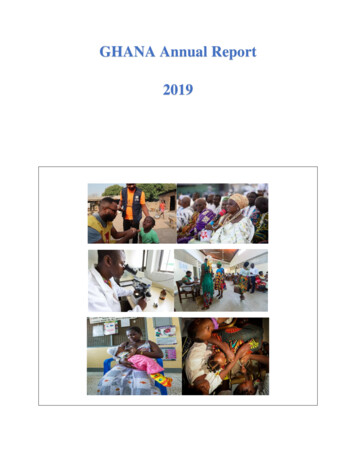
Transcription
GHANA Annual Report2019
ACRONYMSAFP Acute Flaccid ParalysisAFRO WHO Regional Office for AfricaCCS Country Cooperation StrategyCHW Community Health WorkerEPI Expanded Programme on ImmunizationEU European UnionFDA Food and Drugs AuthorityGF Global FundGPW 13 Global Programme of Work 13HiAP Health in All PoliciesIDSR Integrated Disease Surveillance and ResponseIHR International Health RegulationsJEE Joint External EvaluationMoH Ministry of HealthRMNCAH Reproductive, Maternal, Newborn, Child and Adolescent HealthNAPHS National Action Plan for Health SecurityNCDs Non-communicable diseasesNFM New Funding MechanismsOPV Oral polio vaccinePMTCT Prevention of mother-to-child transmissionTB TuberculosisU5MR Under-5 Mortality RateUHC Universal Health CoverageUN United NationsUNICEF United Nations Children’s FundWCO WHO Country OfficeWHO World Health Organization
CONTENT1.02.03.04.05.06.0Communicable Diseases1.1Malaria1.2HIV, Tuberculosis1.3Hepatitis1.4Neglected Tropical Diseases (NTDs)1.5Vaccine Preventable Diseases1.6Malaria Vaccine Implementation ProgrammeNon-Communicable Disease (NCDs) and Mental Health2.1Non-Communicable Diseases (NCDs)2.2Mental Health2.3NutritionPromoting Life through the Life-Course3.1Reproductive, Maternal, Newborn, Child and Adolescent Health3.2Gender Equity and Human Rights3.3Environmental Determinants of Health3.4Celebration of Official Health DaysHealth Systems4.1National Health Policies, Strategies and Plans4.2Access to Medical Product and Strengthening Regulatory CapacityPreparedness, Surveillance and Response5.1Alert and Response Capacities, IHR, IDSR5.2Epidemic and Pandemic Prone DiseasesStaff Movement
ForewordThe focus of the World Health Organization(WHO’s) support during the year under reviewwas on priority areas for both Government andWHO including: improved access to qualityessential health services, attainment ofUniversal Health Coverage (UHC) throughstrengthening of health systems and PrimaryHealth Care, addressing public healthemergenciesandpromotinghealthierpopulations through multisector actions andapproaches.Like preceding years, the office continued to play an active role in existing partnerships andcoordination mechanisms including Development Partners (DPs) Group, UN SustainableDevelopment Partnership (UNSDP) Thematic Working Groups, and the Health Sector WorkingGroup among others.In the reporting year, the main achievements registered by WCO in support of the country’s effortsincluded improved coverage of sexual and reproductive, maternal, neonatal, child and adolescenthealth (SRMNCAH) and priority interventions, increased and sustained vaccination coverage,strengthened country capacity to prevent, detect and respond to public health emergencies,strengthening national capacity and coordination mechanisms in the area of HIV/AIDS, Malaria,TB, Public health emergencies preparedness and response, non-communicable diseases, NTDs andMental Health.It is worth noting that the Country Office played an important role in strengthening national,regional and district health systems and services through people-centered service deliveryapproaches in line with the implementation of the Primary Health Care (PHC) principles.The country office owes a debt of gratitude to office of the Regional Director for Africa, AFROincluding IST and HQ for the support during the year. The office owes same gratitude to theMinistry of Health, the Ghana Health Service, Development Partners and other stakeholders forthe collaboration and teamwork during the year 2019.I would also want to seize the opportunity to thank all WHO staff who dedicated their expertiseand time to support their counterparts and closely worked with health development partners forbetter alignment and harmonization of programmes to the benefit of the Ghanaian people. Thecountry office hopes to work with the same team spirit and enthusiasm in the year 2020 andbeyond.Dr. Neema Rusibamayila KimamboActing WHO Country Representative for Ghana
Executive SummaryThe WHO country office for Ghana, began the year 2019 with a 4-day staff retreat at the BusuaBeach Resort in the Western Region from 04 to 08 March 2019. The theme for the retreat was‘Impacting the Health and Lives of the people of Ghana through the Triple Billion Goal”. The staffoutlined priorities and strategies to strengthen WHO’s contribution to the national health agendaduring the yearWorking in collaboration with the Ministry of Health/Ghana Health Service and other allied healthinstitutions and stakeholders, the WHO country office, provided support aimed at achieving itsmission which is attaining the highest level of health by the people in the country though its sixoperational areas which are (i) Communicable Diseases (ii) Non-Communicable Diseases, (iii)Promoting Health through the Life Course (iv), Health Systems, (v) Preparedness, Surveillanceand Response (vi) Corporate services and enabling functions.In addition to the financial support, technical assistance was also provided to build capacity andstrengthen health governance structures at all levels. The following are some of the achievementsfrom the support provided: Introduction of RTS, S/AS01E malaria vaccine, the world’s first malaria vaccine, intoroutine immunization through the WHO-coordinated Malaria Vaccine ImplementationProgramme (MVIP) Conduct of response vaccination campaigns to Circulating Vaccine-Derived Poliovirus(cVDPV) Type 2 using monovalent oral polio vaccine type 2 (mOPV2) in Bono, GreaterAccra, Northern, North East, Oti, Savanna and Upper East regions. Commemoration of Child Health Promotion Week and Africa Vaccination Week topromote preventive child survival interventions like Immunization, Vitamin ASupplementation, Growth monitoring, birth registration and ITN use Development of a 5-year comprehensive Multi-Year Plan (cMYP) for Immunizations inGhana for the period 2020-2024 Conduct of a comprehensive Reproductive, Maternal, Newborn, Child and AdolescentHealth (RMNCAH) program review to inform policy and programmatic strategic plans
Adaptation of the WHO training package on growth assessment and infant and young childfeeding counselling for Ghana specific training manual to that will be used forstrengthening skills of health workers. Development of the National Multisectoral NCDs Policy and Strategy in collaboration withthe World Bank and other Health Partners Launch of the Quality Rights in Mental Health in Ghana, which is an e-training programmewith online coaching on mental health, human rights and recovery to promote attitudes andpractices that respect dignity and rights, and which promote holistic, person-centered andrecovery-oriented care and support. Commemoration of key health-days such as World Health Day, World No Tobacco Day,World diabetes day to create more awareness on health living and life style. Development of case studies for the chemical events/ environmental surveillancecurriculum for the Ghana Field Epidemiology and Laboratory Training (GFELT) programat the University of Ghana School of Public Health (UGSPH) in collaboration with NIPH Support for meningitis preparedness with the provision of diagnostic laboratory logisticsand support for strengthening surveillance and clinical diagnosis using case definition inUpper West Region.
SIGNIFICANT ACHIEVEMENTS BY CATEGORY OF WORK1.0COMMUNICABLE DISEASES1.1 MalariaMalaria control has seen some remarkable improvement over the past years. Malariatransmission is generally reducing in Ghana. Malaria parasite prevalence has decreased from27.5% in 2011 (MICS, 2011) to 14.1% (MICS, 2019) with varying endemicity across theregions from 2.4% in the Greater Accra Region to 27.0% in the Western Region. In 2019, onemajor activity was a comprehensive review of the Malaria Strategic Plan 2014-2020 whichwas mainly supported by WHO and partners. Key findings from this program review (MPR)indicated that the malaria program is on track to achieving its targets if efforts are sustained.Nationally, the proportion of deaths attributed to malaria per 100,000 population decreasedfrom 10.8/100,000 in 2012 to 1.1/100,000 in 2019 exceeding the national target of 2.5/100,000.Case Fatality Rate among children under five years of age also reduced from 0.6% in 2012 to0.1% in 2019 again exceeding the target of 0.2% set for 2019 (HMIS, 2020).Many of these achievements can be attributed to improved coverage and access to keyinterventions such as the distribution of LLINs, seasonal malaria chemoprevention and indoorresidual spraying for eligible populations over the years. In general, there has been an increaseof Long-lasting Insecticide Treated Net (LLIN) ownership from 68% in 2014 to 73% in 2019.Key Activities, Outcomes and Achievements1.1.1Revision of Guidelines and ToolsDuring the review year, the NMCP was supported to revise various guidelines such as theMalaria Treatment Guidelines, Malaria in Pregnancy Guidelines, Laboratory Guidelinesamong others. Subsequent to this, there were a series of trainings on these which WCOsupported.1.1.2Entomological MonitoringThe Annual Insecticide Resistance Surveillance is a major component of the NationalInsecticide Resistance Management Plan. WCO has been providing continuous funding andtechnical support including field supervision for the entomological monitoring for vector
control to address the emerging insecticide resistance in the country. There are ten sentinelsites across the country for entomological surveillance. This annual activity is carried out incollaboration with Noguchi and supported by USAID PMI. Results from these sites inform theNMCP in the choice of insecticides for vector control interventions such as the Indoor ResidualSpraying.1.1.3Seasonal Malaria Chemoprevention (SMC)Seasonal Malaria Chemoprevention (SMC) is one of the key malaria preventive interventionsfor children 3 months to 6 years. It is carried out annually in four rounds of dosing in the fiveregions of the northern sector of the country. WHO has been a major technical partner for thisintervention providing technical support for the planning as well as field supervision for atleast one of the dosing rounds every year. For the supervision, districts are assessed forpreparedness, logistics management, quality of dosing among others. This intervention hasbeen very successful with average coverage of more than 90%. In 2019 WHO again supportedthe field supervision of this exercise in the Upper East, Northern and Upper West regions.WHO supports SMC in Upper East Region.1.2 HIV, TuberculosisKey Activities, Outcomes and Achievements1.2.1Reprogramming of Global Fund NFM 2 Grant ApplicationSupport was provided to the National AIDS control program and the National TB controlprogram to successfully reprogram the Global Fund grants for TB and HIV. This interventionwas critical to maintain critical funding for the HIV and TB programs in Ghana. The supportinvolved working together across the three levels of WHO, three consultants provided incountry support, whiles colleagues at AFRO and HQ provided continuous review of documentsthroughout the process.
The reprogramming aimed at enabling the HIV and TB programs accelerate progress towardsthe 90-90-90 targets and the End TB goals respectively. The reprogrammed HIV operationalplan emphasized innovative differentiated testing approaches, decentralization of ownershipof interventions to sub-national levels whilst promoting integration and increased involvementof CSOs and the private sector. The TB plan focused on improving TB case finding byintroduction of a Sputum Sample referral system that would make the 126 GeneXpert machinesaccessible to over one thousand health facilities across the country.1.2.2Implementation of Accelerated Plan for HIV and TuberculosisThe NFM 2 grant reprogramming resulted in accelerated plans for achieving the 90-90-90targets and increasing TB case detection. WHO provided continuous support to the HIV andTuberculosis programs for the implementation of the accelerated plans.The Tuberculosis program successfully rolled out the innovative sputum transport system thatis expected to link over 1000 health facilities to the 126 GeneXpert sites and thereby improvethe diagnostic capacity at the peripheral level and improve TB case detection rate. Preliminaryresults as at January 2020 showed marked increase of 26% in the case detection rates fortuberculosis across the country compared with January 2019.The National AIDS control program has been supported by organizing monthly update callswhere programmatic data and performance is reviewed and required technical supportprovided for improved performance. This has resulted in the NACP achieving allprogrammatic targets set for 2019, better positioning the country to accelerate progress towardsthe 90-90-90 targets which stood at 58-77-68 as at the end of 2019.1.2.3Review of National Guidelines and Tools for HIVSupport was provided to update HIV testing and treatment guidelines to conform with WHOrecommendations and global and regional best practices.For testing the changes include differentiated testing approaches such as index client testing,switch from two tests to three test algorithms, use of HIV-Syphilis Combo test for ANC clientstesting amongst others. For treatment, the guidelines were reviewed to include use ofDolutegravir based regimen as first line for adolescents and adults and Lopinavir for pediatric
regimen. Data collection tools such as testing registers and ART primary data collection toolswere also revised and updated to reflect the changes in the guidelines.The National HIV/AIDS control program was also supported to revise primary data collectiontools such as the ART folder as well as registers for HIV testing. The revision was relevantmake the data collection tools responsive to new and innovative interventions such asdifferentiated service delivery and Index testing.1.2.4Programmatic Review of National Strategic Plan for TB
GHANA Annual Report 2019 . ACRONYMS AFP Acute Flaccid Paralysis AFRO WHO Regional Office for Africa CCS Country Cooperation Strategy CHW Community Health Worker EPI Expanded Programme on Immunization EU European Union FDA Food and Drugs Authority GF Global Fund GPW 13 Global Programme of Work 13 HiAP Health in All Policies IDSR Integrated Disease Surveillance
